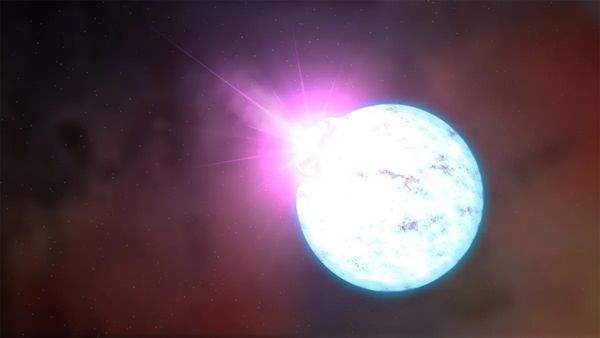Ultra-powerful plasma 'blades' could slice entire stars in half, new paper suggests
Stars could be sliced in half by "relativistic blades," or ultra-powerful outflows of plasma shaped by extremely strong magnetic fields, an unpublished paper claims.

Stars could be sliced in half by "relativistic blades," or ultra-powerful outflows of plasma shaped by extremely strong magnetic fields, a wild new study suggests. And these star-splitting blades could explain some of the brightest explosions in the universe.
The study authors, based at the Center for Cosmology and Particle Physics at New York University, outlined their results in a paper published in September to the preprint database arXiv. The study has not yet been peer-reviewed.
The researchers were hunting for the origins of certain types of gamma-ray bursts (GRBs). GRBs are some of the most powerful explosions in the sky, but they typically occur so far away we can only see them as a brief but intense blip of excess gamma-ray radiation. Only a handful of known objects can generate the energies required to power a GRB, and so most astrophysicists assume that either black holes or magnetars are involved — likely when they are engaged in something violent like ripping a star apart. However, astronomers have struggled to explain why some GRBs fade away very slowly.
Related: Extremely flat cosmic explosion dubbed 'the Cow' defies explanation
In the new study, the authors suggest that these lingering GRBs may occur when some massive stars die. The core of the star collapses, forming a neutron star, which is a city-sized ball of ultra-dense neutrons, surrounded by the heavy layers of hydrogen and helium. That neutron star can acquire an extremely strong magnetic field through rapid compression and rotation. This turns the neutron star into a magnetar, which hosts the most powerful magnetic fields in the known universe.
The newborn magnetar is surrounded by chaos. Its own gravitational pull draws the remaining atmosphere of the parent star onto it, but the intense radiation and magnetic fields whip that plasma around in a frenzy. In previous work, astronomers concluded that in this maelstrom, a jet forms along the spin axis of the magnetar, punching its way through the dying star.
But the authors of the new study realized that the magnetar's magnetic fields can also beam intense bursts of radiation along the magnetar's equator. Shaped by the extreme centrifugal forces of the rotating star, these beams of radiation form a blade that moves outward through the star at nearly the speed of light, carrying more energy than a supernova explosion.
Get the Space.com Newsletter
Breaking space news, the latest updates on rocket launches, skywatching events and more!
This "relativistic blade" can perfectly bisect the star, slicing it in half on its way out, the study authors found.
The blade then travels for a distance well over several times the radius of the original star before it finally loses steam, potentially explaining some longer-lasting GRBs.
The star's fate is sealed. During the blade's travel, it picks up more and more material that eventually joins the blade in its outward journey. The blade also causes instabilities within the star itself that lead, eventually, to its demise.
For this study the researchers simply demonstrated that a relativistic blade could explain such GRBs. For their next step, the researchers plan to study how the blade evolves with time, and exactly how the ensuing stellar death unfolds.
That would enable them to identify key signatures of this type of explosion and determine if some GRBs scientists have previously observed can be explained with this model.
Join our Space Forums to keep talking space on the latest missions, night sky and more! And if you have a news tip, correction or comment, let us know at: community@space.com.

Brandon has been a senior writer at Live Science since 2017, and was formerly a staff writer and editor at Reader's Digest magazine. His writing has appeared in The Washington Post, CBS.com, the Richard Dawkins Foundation website and other outlets. He holds a bachelor's degree in creative writing from the University of Arizona, with minors in journalism and media arts. He enjoys writing most about space, geoscience and the mysteries of the universe.










